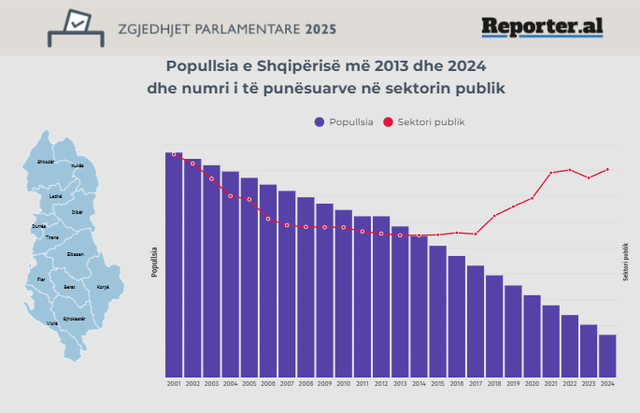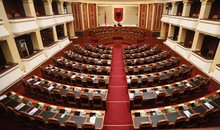
 Flash News
Flash News
Don't lose face/ After Rama's 'threat', SP candidates withdraw request from CEC
VIDEO/ The assassination in Durrës, the moment of the murder of 29-year-old Ermir Dedja
Assassination of Ermir Dedja in Durrës, the murder weapon and a burned car are found in the village of Gërdec
"Toyota Yaris" file, GJKKO sentences the former chief prosecutor of Vlora to 2.8 years in prison
Makinën plot me d*ogë, vihen në pranga dy persona në aksin “Mamurras-Kashar”
Administration's Inflated: How Did "Directors' Politics" Affect the May 11 Elections?

The public sector in Albania has been bloated and overburdened with additional employees in recent years, especially at the level of directors and unskilled workers, while the decline in the population due to emigration has caused the number of employees in relation to the population to grow even faster, official figures from the Institute of Statistics analyzed by BIRN suggest. At the end of 2024, the public sector, which includes the central administration, local government and enterprises with public share capital, had 184,000 employees, an increase of 20,000 people or 12.4% compared to 2013, when the Socialists first took power. The increase in public sector employees began after 2018 and peaked in 2021 and 2024, both election or pre-election years. The increase in the public sector has been particularly large at the director level, making it effective by 2023 for there to be one director for every eight specialists and ordinary workers.
While the number of employees in the state has increased, the population that these employees theoretically serve has decreased. The 2023 census data recorded a resident population in Albania of 2.4 million inhabitants, down from 2.82 million reported in 2011. Consequently, the number of employees in the public sector per 100 inhabitants has increased, from 6 per 100 to 7.8 per 100.
International observers reported in their preliminary report on the May 11 elections in Albania that public sector employees were put under pressure in these elections and that allegations and reports of pressure on the public sector were “widespread.” The observers point directly to Rama’s rallies with women, in which, as the report notes, the participants were mostly public sector employees and that in four cases, some of them told observers that they had been asked to appear at the prime minister’s rallies.
Abuses and pressures on the public sector are not new in Albanian elections, but what has been observed in the recent elections, and the language used by international observers, is truly unprecedented. For example, before the 2013 elections, the Socialist Party complained to international observers about cases of dismissals from public sector jobs of its supporters, and the observers, in the report of those elections, considered the SP’s complaints as “credible”. But this also means that, in 2013, eight years after the Democrats came to power, there were opposition supporters in the public sector, which cannot be said so easily today.
Sipas raportit të vëzhguesve ndërkombëtarë, por edhe sipas shumë politikanëve dhe aktivistëve, shfaqja e mbështetjes për një parti opozitare është e mjaftueshme për ta pushuar dikë nga puna, ndërsa disa kandidatë që garuan në zgjedhje për Partinë Socialdemokrate të Tom Doshit e gjetën veten pa punë menjëherë pasi shpallën kandidaturën.
Partitizimi i plotë i administratës publike dallohet edhe nga një analizë e jetëshkrimeve të kandidatëve për deputetë të kryer nga BIRN para zgjedhjeve, në të cilën vihet re se mbi 90% e kandidatëve të Partisë Socialiste vijnë nga radhët e administratës publike ndërsa mes mbi 2 mijë kandidatëve të opozitës kryesore apo partive të reja, nuk ka pothuajse fare punonjës të sektorit publik.
Përdorimi i administratës publike si levë në zgjedhje ka gjasa do të ketë pasoja afatgjata në demokracinë shqiptare, pasi të 184 mijë punonjësit e sektorit publik janë mjaftueshëm për t’i dhënë qeverisë avantazhin që i nevojitet në zgjedhje përkundrejt çfarëdolloj kandidati apo kandidatësh nga opozita. Partia Socialiste fitoi zgjedhjet e 11 majit pasi mori brenda vendit 734 mijë vota, rreth 35 mijë më pak se sa në zgjedhjet e vitit 2021. Por për shkak se popullsia e përgjithshme votuese ka rënë me 200 mijë, votat e PS-së u përkthyen në një përqindje edhe më të lartë nga sa ishin katër vjet më parë.
Të punësuarit në sektorin publik ndahen për efekt administrativ në të punësuar të qeverisë qendrore dhe në të punësuar të tjerë. Sektori buxhetor i qeverisë qendrore, shifrat e punësimit të së cilës janë pjesë e buxhetit që miratohet në parlament, ka pësuar rritje më të vogël në dekadën e fundit dhe këtë vit pritet të jete 85 mijë. Këtu përfshihen të punësuarit e sektorëve kyçë si shëndetësia dhe arsimi. Ajo që është shtuar është sektori i të punësuarve në pushtetin vendor si dhe në ndërmarrjet publike, të tilla si Posta Shqiptare, OSHEE e të tjera. Transparenca e të dhënave në këtë sektor nuk krijon mundësi për të parë se ku specifikisht janë shtuar të punësuarit dhe çfarë bëjnë të punësuarit shtesë. Ajo që dihet janë vetëm shifrat finale: Në vitin 2013 kishte 164 mijë të punësuar në sektorin publik, në dhjetor 2024 kishte 184 mijë.
Drejtorë dhe punëtorë
The Institute of Statistics publishes data on employees in the public sector divided by occupational group. This means that it is possible to see not only the total number of employees, but also at which levels we have had additions. Detailed data in this way is available until 2023. Of the 17 thousand additional employees that have been recorded from 2013 to 2023, it is noticeable that a full 6700 are in the category of Legislators, senior civil servants and managers, while 11 thousand have been added to the specialist level. Despite the addition to directors and specialists, the addition to the category of Ordinary Civil Servants is only 1600, while that of the Workers level is only 4,400 people. In short, the public sector has been inflated with 6700 directors, who have to manage the work of 11 thousand specialists and a little over 6000 workers and ordinary civil servants. The number of employees in a category called Technicians and Assistant Specialists has decreased by about 6 thousand.
Such a rapid increase in directors in relation to total employees meant that in 2013 there was one senior manager for every eight employees in the public sector, compared to one for every twelve a decade ago.
In a normal situation, the number of public sector employees should follow the population. Given that the population has fallen by 14% since the Socialists came to power in 2013, the number of public sector employees should have fallen to 140,000 today from 184,000. In short, one in three people employed in the public sector seems like too much. The public sector wage bill, around 1.1 billion euros in 2024, would have to be over 300 million euros lower if the number of employees in the state were to be within what is reasonable for a country with Albania’s current population. The 300 million euros would normally enable public investment or social policies, such as pension increases, while the countless directors in question would have to accept working in the private sector, where the added value of work is measured in money, not votes./ BIRN


Latest news


Enigma/ How did the SP grow more than in the previous elections this year?
2025-05-20 15:12:50
Threat against President Osmani, KMDLNJ: Risk to security and democracy
2025-05-20 15:01:56

Hungary's parliament approves withdrawal from the International Criminal Court
2025-05-20 14:50:00
Defamation lawsuit against Albana Vokshi, hearing postponed at the GJKKO
2025-05-20 14:36:20
Names/Who are the 140 MPs who will sit in the Assembly?
2025-05-20 14:21:57
Why don't young people want to get married anymore?
2025-05-20 14:15:27
EU approves new sanctions against Russia
2025-05-20 13:49:54
Flax seeds, positive and negative effects of their consumption
2025-05-20 13:45:54

Pope Leo XIV's house goes up for auction for $250,000
2025-05-20 13:23:49

Don't lose face/ After Rama's 'threat', SP candidates withdraw request from CEC
2025-05-20 13:02:09
Berisha warns Rama: You will not stay in power with this farce
2025-05-20 12:55:00



RTSH's official website hacked, fake news about Kosovo appears
2025-05-20 12:10:17

Accident in Korça, motorcycle collides with car, 45-year-old injured
2025-05-20 11:44:48


Germany/ 46-year-old Albanian injures three people, including an 11-year-old
2025-05-20 11:12:01
What does the agreement between Britain and the EU contain?
2025-05-20 11:01:38


Kosovo bans chicken imports from Brazil
2025-05-20 10:33:45
Makinën plot me d*ogë, vihen në pranga dy persona në aksin “Mamurras-Kashar”
2025-05-20 10:23:33
How does speaking multiple languages change the brain?
2025-05-20 10:15:05
Photo/ This is the 29-year-old who was executed in Durrës
2025-05-20 10:00:39
Foreign exchange/ How much foreign currencies are bought and sold today
2025-05-20 09:51:04




Discover the main signs that indicate your body lacks vitamin D
2025-05-20 09:06:39

Horoscope, what do the stars have in store for you today?
2025-05-20 08:50:06

He was executed by masked men, who is the 29-year-old who was killed in Durrës?
2025-05-20 08:28:21
Assassinations in Durres, 29-year-old executed
2025-05-20 08:14:59
Clear skies and light clouds, this is the weather forecast for Tuesday
2025-05-20 08:05:40
Posta e mëngjesit/ Me 2 rreshta: Çfarë pati rëndësi dje në Shqipëri
2025-05-20 07:50:55
"We broke a myth", Shabani: The Shehaj-Lapaj debate also harmed us
2025-05-19 22:59:18




Shkullaku: With the vote of the diaspora, a slaughterhouse has been created
2025-05-19 21:46:19
CEC orders recount in 2 polling centers in Elbasan and Durrës
2025-05-19 21:33:47

250 euros a night for virtual clients, online prostitution discovered
2025-05-19 21:17:10
Yrshek, 15-year-old hits and kills an elderly man
2025-05-19 21:07:05

Adoption in Albania: The system that "holds" abandoned children hostage
2025-05-19 20:52:27

Counting for preferential vote in Tirana ends, Xhaçka receives mandate
2025-05-19 20:23:22
Kosovo President Vjosa Osmani receives death threat
2025-05-19 19:47:49



Safet Gjici's release, lawyer: Today the true face of justice was seen
2025-05-19 19:02:46

King Charles writes to Biden after being diagnosed with cancer
2025-05-19 18:34:07

Ceasefire in Ukraine, Trump holds phone conversation with Putin
2025-05-19 18:24:47
56-year-old Albanian man in Italy dies at work after being hit by truck
2025-05-19 17:52:50


Migrant boat sinks off French coast, 1 dead, more than 60 rescued
2025-05-19 16:58:47
January-March, the number of births fell by 14%
2025-05-19 16:48:50

Nothing new from Edi Rama's politically subjugated justice
2025-05-19 16:33:53
Diagnosed with cancer, Biden breaks silence
2025-05-19 16:14:30

Pensions with Italy, here's what immigrants benefit from
2025-05-19 15:56:54

He fell from the church roof, the priest was brought by helicopter to Tirana
2025-05-19 15:40:16
Who spends more money, men or women? The statistics speak for themselves
2025-05-19 15:28:57
Car collides with Fier-Roskovec bus, one injured
2025-05-19 15:24:03
Since... what if...
2025-05-19 15:05:20

"Partizani" file, GJKKO passes Berisha and Malltezi on trial
2025-05-19 14:46:23
The euro exchange rate starts the week falling, near its historical minimum
2025-05-19 14:32:43
Britain agrees to restore trade and defense ties with the EU
2025-05-19 14:22:32

Liberian footballers remain stranded in Albania, football club did not pay them
2025-05-19 14:00:16
Shkodra Police Destroy Over 1,500 Narcotic Plants
2025-05-19 13:48:24
A phone call in Albania becomes a "bone of contention" between Meloni and Macron
2025-05-19 13:35:31
The drop in domestic prices reduces milk imports for January-April by 15%
2025-05-19 13:30:06
EC report: Albania's economy expected to slow down in 2025-2026
2025-05-19 13:18:06

Safet Gjici released from prison due to serious health condition
2025-05-19 12:56:05




NAME/ Priest falls from church roof in Korça, taken to hospital
2025-05-19 12:08:02
